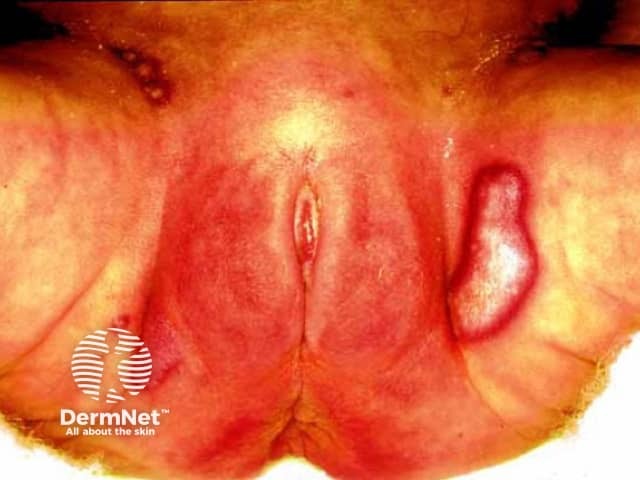Main menu
Common skin conditions

NEWS
Join DermNet PRO
Read more
Quick links
Granuloma gluteale infantum — extra information
Introduction
Demographics
Causes
Clinical features
Complications
Diagnosis
Differential diagnoses
Treatment and outcome
What is granuloma gluteale infantum?
Granuloma gluteale infantum is a rare form of napkin dermatitis in which there are reddish-purple nodules in the napkin (diaper) area of infants. It was first described in 1891 as 'vegetating bromidism' owing to its occurrence following the use of topical bromide-containing ointments [1,2].
The term 'granuloma' is a misnomer, as the histological examination of granuloma gluteale infantum does not reveal any granulomas [3].

Granuloma gluteale infantum
Who gets granuloma gluteale infantum?
Granuloma gluteale infantum usually occurs in infants aged 1–9 months. It is more common in infant boys than in girls [4].
A similar disorder, named granuloma gluteale adultorum, is rarely observed in bed-ridden adults with incontinence (incontinence-associated dermatitis).
What causes granuloma gluteale infantum?
Granuloma gluteale infantum is a complication of irritant contact dermatitis (napkin dermatitis). The exact cause is unknown [5]. No correlation has been found between the severity of napkin dermatitis and the incidence of granuloma gluteale infantum [4].
Possible causative factors include:
- Occlusion from nappies or plastic pants
- The prior use of topical corticosteroids for napkin dermatitis
- The prior use of benzocaine (a topical anaesthetic agent)
- Infection with Candida albicans.
What are the clinical features of granuloma gluteale infantum?
Granuloma gluteale infantum is characterised by asymptomatic firm erythematous or violaceous nodules. The nodules are located in inguinal folds, on the convexities of the buttocks, and less commonly, in the scrotal area and medial thighs.
The nodules are often ovoid in shape and are typically 0.5–4 cm in size, with the long axis lying parallel to skin-fold lines.
What are the complications of granuloma gluteale infantum?
Granuloma gluteale infantum may result in post-inflammatory hyperpigmentation and atrophic scarring.
How is granuloma gluteale infantum diagnosed?
Granuloma gluteale infantum is suspected from the infant patient’s clinical history and the findings on examination of the infant's napkin region.
The diagnosis can be confirmed by biopsy and histological evaluation. A dense dermal inflammatory perivascular infiltrate of lymphocytes, neutrophils, eosinophils and plasma cells is seen, with overlying parakeratosis and hyperplasia of the epidermis [6].
What is the differential diagnosis for granuloma gluteale infantum?
Other forms of napkin dermatitis can be differentiated from granuloma gluteale infantum by the clinical features.
- Jacquet erosive dermatitis refers to tender punched out ulcers occurring in infants over 6 months old that are due to infrequent nappy changes and poor hygiene.
- Infantile seborrhoeic dermatitis is a flexural rash that often involves the infant's eyebrows and scalp (cradle cap).
- In C. albicans infection, there are erythematous patches in the skin folds and a positive fungal culture; the rash responds to topical antifungal therapy.
Less common conditions that may require consideration include:
- Allergic contact dermatitis
- Tinea corporis
- Langerhans histiocytosis
- Mastocytoma
- Perianal pseudoverrucous (wart-like) papules
- Kaposi sarcoma
- Scabies nodules [7].
What is the treatment and outcome for granuloma gluteale infantum?
Granuloma gluteale infantum lesions are typically resistant to treatments with barrier creams, antifungal agents, and topical steroids.
The napkin region of the affected infant should be cleaned, kept dry, and moisturised. Candida albicans should be treated with a topical antifungal agent. The nodules spontaneously regress within 1–2 months without any active treatment, often leaving an atrophic scar.
References
- Simmons IJ. Granuloma gluteale infantum. Australas J Dermatol, 1997; 18: 20–4. DOI: doi.org/10.1111/j.1440-0960.1977.tb00728.x. Journal
- Tappeiner J, Pfleger L. Granuloma gluteale infantum. Hautarzt, 1971; 22: 383–8. PubMed
- Bluestein J, Furner B, Phillips D. Granuloma gluteale infantum: a case report and review of the literature. Padiatr Dermatol, 1990; 7: 196–8. DOI: 10.1111/j.1525-1470.1990.tb00281.x Journal
- Bonifazi E, Garofalo L, Lospalluti M, Scardigno A, Coviello C, Meneghini CL. Granuloma gluteale infantum with atrophic scars: clinical and histological observations in eleven cases. Clin Exp Dermatol 1981; 6: 23–9. DOI: 10.1111/j.1365-2230.1981.tb02264.x. Journal
- Walsh SS, Robson WJ. Granuloma gluteale infantum: an unusual case complication of napkin dermatitis. Arch Emerg Med 1988; 5: 113–5. PubMed Central
- Al-Faraidy N, Al-Natour S. A forgotten complication of diaper dermatitis: granuloma gluteale infantum. Journal of Family and Community Medicine: 17(2): 107–9. DOI: 10.4103/1319-1683.71994. PubMed
- de Zeeuw R, van Praag M, Oranje A. Granuloma gluteale infantum: a case report. Pediatr Dermatol 2000, 17: 141–3. DOI: 10.1046/j.1525-1470.2000.01734.x. Journal
On DermNet
Other websites
- Granuloma gluteale infantum — Medscape
